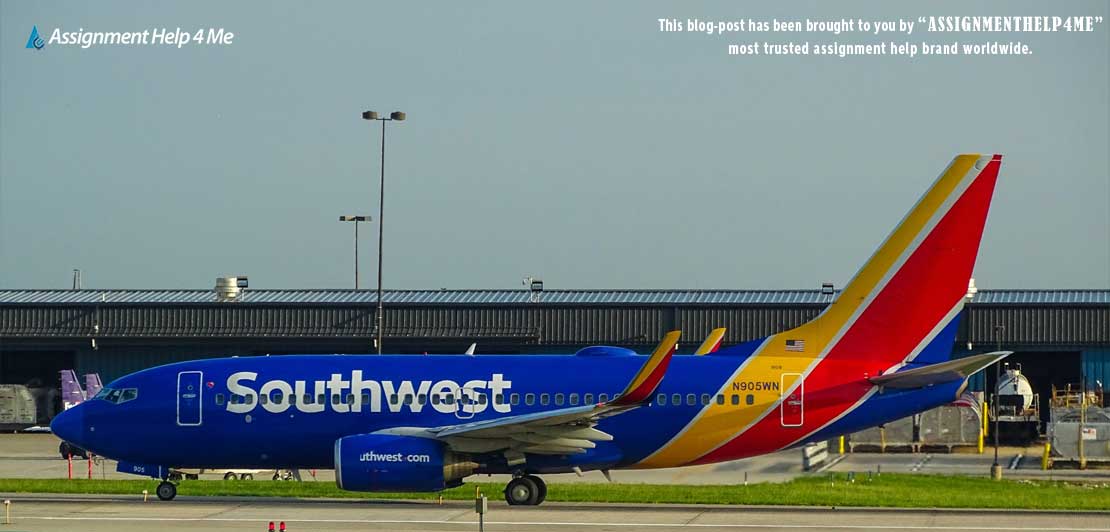
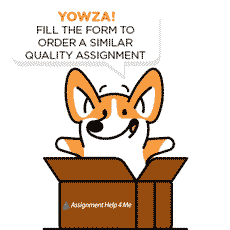
Contents
- Introduction to Southwest Airlines
- Southwest Airlines company profile
- History of Southwest Airlines
- Southwest Airlines mission and vision statement
- Southwest Airlines industry analysis
- Southwest Airlines core values
- Southwest Airlines external analysis
- Southwest Airlines competitor’s Analysis
- Southwest Airlines internal analysis
- Southwest Airlines marketing analysis
- Recommendations for Southwest Airlines
- Conclusion
- References
An epigrammatic strategic analysis of Southwest Airlines
Isabelle Taylor | 30 Sep,2021
Introduction
This thoughtful article aims to perform a detailed strategic analysis of the current performance and growth prospects of Southwest Airlines, one of the leading airlines in the US. After reading this article, you will get to know about the growth factors relevant to the airline industry in the US and the market opportunities available to Southwest Airlines. The article also includes an evaluation of the internal and external market conditions of Southwest Airlines through the effective use of various strategic evaluation models and tools. The end section of the article sheds light on different measures that can be taken by Southwest Airlines to improve its competitive position in the industry.
Southwest Airlines company profile
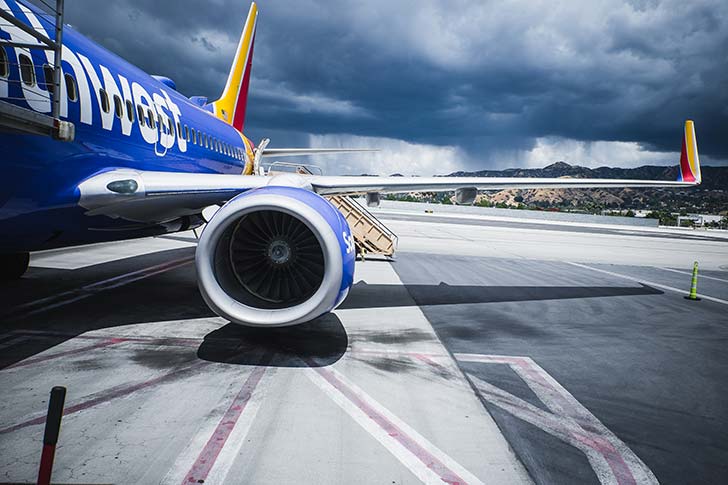
Southwest Airlines Co. is an American airline company that has its headquarters in Dallas, Texas. The airline operates around 4000 departures per day during the peak travel season. Southwest Airlines Co. features low-fare services and frequent flights of short routes (Simple Flying, 2021).
Southwest Airlines History
Southwest Airlines was founded on March 15, 1967, by Herb Kelleher and Rollin King and was initially named Air Southwest Company. The company began operating as the intrastate airline company within Texas with flights flying between Dallas, Houston, and San Antonio. Moving further, the company started operating interstate in 1979 by scheduling flights in adjacent states. In addition, the airline services were extended to east and southwest locations in the 1990s. However, since the early 21st Century, there has been an increase in the financial difficulties in the airline industry which resulted in the restructuring of Southwest Airlines Co. The key measures being taken by Southwest Airlines include the appointment of a new president, Colleen Barrett in 2001 and the establishment of new initiatives such as self-service check-in kiosks in 2002 and online boarding passes for guests in 2004. Between 2004 to 2005, the airline company also participated in different television reality shows on the A&E Network to improve its brand image and recognition. Moving further, in 2008, Barrett was replaced by a new president i.e. Gary Kelly who still serves the top post. Southwest Airlines Co. currently operates the airline services in 45 states and multiple Central American destinations. Further, the company earned a revenue of USD 9 billion in 2020.
Southwest Airlines mission and vision statement
The mission of Southwest Airlines is to deliver high-quality customer service with a focus on warmth, friendliness, individual pride, and company spirit. The vision of Southwest Airlines is “To be the world's most loved, most efficient, and most profitable airline”.
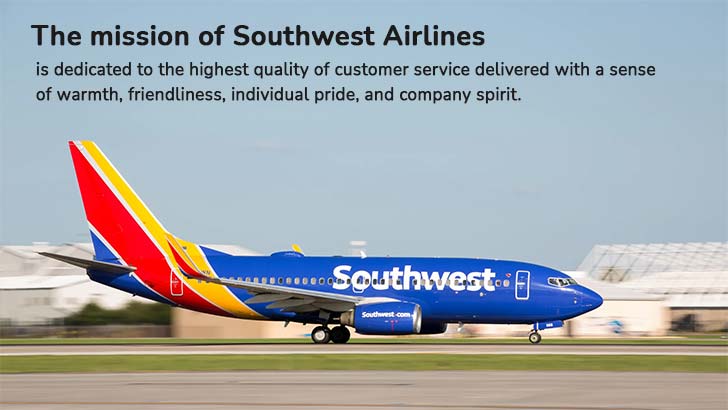
Southwest Airlines industry analysis
The airline industry had been growing at a very fast pace at the global level but the outbreak of COVID-19 paralyzed the growth of the aviation industry in 2020 due to international travel bans and the threat of COVID-19. The revenue of the aviation industry at the global level was continually growing at a CAGR rate of 5.3 % from 2009 to 2019 but it is only in 2020 that the aviation industry has faced massive set backs.
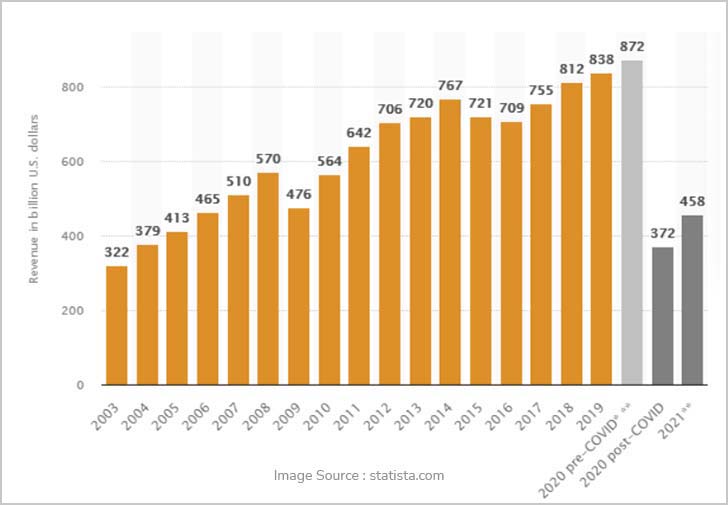
The United States, China, EU, and Brazil are major markets for air travel and Southwest Airlines is one of the main airline companies in the low-cost category (Statista, 2021). Further, the market size of the domestic airline industry in the US is $106.3bn and the domestic airline industry is expected to increase 59.7 % in 2021 (IBISWorld, 2021). The revenue in the airline industry of the US is also expected to reach US$50,341 million by the end of 2021 with an expected growth rate of 29.07 % per year.
The United States had the largest commercial air travel market in 2019 with over 926.7 million passengers. The highest airline traffic in the US depicts strong growth potential for Southwest Airlines. Further, the second-largest market in the airline industry is China with around 660 million passengers in 2019.
Southwest Airlines Core values
The core values of Southwest Airlines include friendly customer experiences, safety, reliability, lower cost, and selfless service. The main focus of Southwest Airlines is to create a warm, passionate, friendly, carefree, and respectful environment for the workers with the aim to offer friendly customer service. The company also prioritizes the safety of its customers as well as employees in all its operations to further ensure the development of a conducive working environment. Even though the quality of service is important in the airline industry, the price of the service also matters a lot. Southwest Airlines focuses on providing low-cost services to the passengers which help to attain a significant competitive position in the industry (Business, 2020). The list of core values adopted by Southwest Airlines is shown in the table as follows-
| Southwest Airlines Core values | List |
|---|---|
| Warrior Spirit |
|
| Fun-LUVing Attitude |
|
| Servant’s Heart |
|
| Promote safety |
|
| Low cost |
|
| Quality customer service |
|
Southwest Airlines external analysis
Southwest Airlines PESTEL analysis
PESTEL Analysis is an important external market analysis tool that helps to evaluate the external market conditions of an organization. To study the external market conditions for the growth of Southwest Airlines, a thorough PESTEL analysis is presented below.
Political factors affecting Southwest Airlines
The US-China trade war is one of the main political factors that has negatively impacted the growth of airline companies. The implementation of trade tariffs further increased pressure on the airline earnings with a decline in the growth of the cargo businesses (Chee, 2019). The operations of Airlines in the US are managed by the “Federal Aviation Administration” which regularly sets the policies and procedures for airline companies. The FAA sets licensing regulations for airlines and issues economic authority to the carriers to serve in the US. Along with this, the FAA also ensures the safety of passengers in all operations. However, Southwest Airlines faced a number of cases of misconduct by the passengers and on 25 May 2021, the Southwest Airlines flight attendant also lost two teeth in an attack in the US due to the unruly passengers (Aljazeera, 2021). As a result of this, the FAA has necessitated the US airline companies to take extensive measures to report unruly passengers under its initiative of proposing a no-fly list of unruly passengers (Shepardson, 2021).
Economic factors affecting Southwest Airlines
The airline industry of the United States is growing at a faster pace and it is only during 2020 that the growth of the airline industry was disrupted as a result of the outbreak of COVID-19. The airline industry of North America was also valued at $ 59.2 billion during 2020 which is also projected to reach $ 104.99 billion in 2026. The global aviation industry was also valued at US $ 169.72 billion in 2020 and is also expected to grow at a CAGR rate of 4% between 2021 to 2026 (Mordorintelligence, 2021). However, the main factor that is affecting the growth of the airline industry in the United States is rising fuel prices. The US Jet fuel prices also reached $1.67 a gallon which is expected to increase the overall cost of airline operations (Josephs, 2021). Along with this, the ongoing COVID-19 pandemic also has caused an aviation crisis with the imposition of various travel restrictions and suspension of flights. Moreover, air traffic in North America will decline by 56% in 2020 as a result of a decline in the travel intention of the passengers and the closure of various tourism destinations.
Social factors affecting Southwest Airlines
The propensity to travel is highest among the millennial group of individuals aged 23 to 38 years as millennial individuals travel more frequently than any other group of individuals. Generation Xers and millennials also have strong intentions to explore exciting new locations which also influence their travel intention (Airways, 2020). However, the demand for travel had been negatively impacted during COVID-19 due to the rise in the threat of the spread of infection among individuals. Despite this, the airline sector is still expected to grow at a faster rate in the post-COVID period due to changes in customer behavior and an increase in individual intention to visit leisure trips.
Technological factors affecting Southwest Airlines
Technological factors play an important role in the growth of the aviation industry as technological up-gradation helps to ensure customer safety, convenience, and increased competitive position of the airline companies. Despite the fuel-efficient Technologies, digitalization and safer flight technology also help airline companies to succeed in a highly competitive environment. As a result of this, the airline industry is working on game-changing innovations to improve customer service experiences. Moreover, various airline companies are also promoting the use of Robotics to enhance automation in the aviation industry and to ensure punctuality of services for the passengers. Not just this, various other technologies such as virtual reality, AI, self-driving wheelchairs, etc. are used to further promote automation and to ensure a higher customer service experience. Southwest Airlines is also building up an innovation lab in Dallas to further provide training to the employees and to improve innovation in its operations (Future, 2021).
Environmental factors affecting Southwest Airlines
Environmental factors have continued to gain significant importance in the airline industry as aircraft emissions place a huge impact on the environment. The noise from the air traffic not only causes unpleasant experiences but also negatively impacts the health of the citizens. Currently, aviation represents 11 % of the total US transportation-related emissions which are further expected to increase with the rise in the growth of the aviation industry. As a result of this, president Biden has implemented various regulations to promote zero-carbon aviation and to achieve the climate goals by mitigating the issues of climate change. Further, sustainable aviation fuel tax credit is also proposed by the president as part of the build-back better agenda to reduce cost and improve sustainable fuel production for aviation. Along with this, FFA is also launching the third phase of the CLEEN program to award more than $ 100 million for the aircraft companies for developing fuel-efficient Technologies or Technologies that helps to reduce emissions and noise (Biden, 2021)
Legal factors affecting Southwest Airlines
The airline companies are also required to comply with various regulations and legislation such as the clean water act, clean air act, safe drinking water act, resource conservation, and recovery act to further promote Environment protection. Not just this, the airline companies in the US are regulated by the Federal Aviation Administration where the FAA evaluates whether the Airline companies meet the safety regulations and standards. Along with this, carriers are also required to comply with Federal Aviation Act 1958, Airport and Airway development act 1970, etc.
Southwest Airlines Porter Five Forces analysis
Porter Five Forces analysis is an important competitor analysis tool that helps to evaluate the competitive position of the organization by analyzing the five factors. The Porter Five Forces analysis of Southwest Airlines is executed in the table given below.
| Porter five forces | Level | Explanation |
|---|---|---|
| Bargaining power of buyers | High | The bargaining power of buyers of Southwest Airlines is high as there is a lack of differentiation in the services being offered by the low-cost carriers. The customers tend to select the airline that offers the best airline services. Moreover, widely available information Technologies provide the ability to the customers to compare flight services and their prices before making the final decisions which also reduces the switching cost for the customers. |
| Bargaining power of suppliers | High | The bargaining power of suppliers for Southwest Airlines is also very high and the main aircraft suppliers of Southwest Airlines are Boeing and airbus. The switching cost for Southwest Airlines from one supplier to the other is also very high due to higher training costs for the pilots. Moreover, the company also relies heavily on the few suppliers for the oil which also raises the bargaining parts of the suppliers. Not just this, the company uses only Boeing 737 aircraft in its fleet due to the higher fuel efficiency of this aircraft which further increases the bargaining power of the supplier. |
| Threat of substitute | Moderate | The threat of substitutes in the airline industry is moderate. The passengers have limited options in the airline industry and Southwest Airlines offers high-quality airline services at a low cost as compared to the other airlines. However, the number of low-cost carriers such as Frontier, Spirit, and Allegiant in the airline industry is increasing in the US airline industry which has increased the threat of substitutes for Southwest Airlines. |
| The competitive rivalry among the existing firms | High | The level of competitive rivalry among the existing firms in the US airline industry is very high due to the presence of a large number of airline companies including Southwest Airlines, JetBlue Airways, American Airlines, Alaska Air Group, Delta Airlines, etc. Along with this, Delta airline and American Airlines have achieved a leading position in the airline industry due to their strong brand name and years of operation in the industry. Moreover, the competition among the existing firms in the industry also resulted in growing price wars and competitive challenges in the industry. |
| Threat of new entry | Low | The threat of new entrants is low in this industry due to large capital investment, strong brand image, and economies of scale of the existing firms. Moreover, rising price wars and lower profit margins of airline companies have made it difficult for new firms to enter the industry. Not just this, various risks and challenges such as higher taxes and aggressive regulations of the Federal aviation administration also have resulted in a reduced threat of entry of the new firms in the industry. |
Southwest Airlines Competitor’s analysis
Southwest Airlines competitors
Southwest Airlines is one of the largest US-based airlines that has operations across 40 states of the United States and also at some International destinations. The company employs a point-to-point Service model and rolling hub model which is different from the business operating model of competitors that uses a hub and spoke model. The main competitors of Southwest Airlines include Delta Airlines, American Airlines, JetBlue Airlines, United Airlines, Virgin America, Alaska Air Group, SkyWest Airlines, etc. The revenue of the major domestic airlines of US is illustrated as follows-

From the above graphical representation, you must have got the idea that Southwest Airlines is one of the major airlines in the US.
Southwest Airlines is known for its low-cost carrier services and in 2018, it was the largest domestic carrier that carried around 163.6 million passengers. As compared to this, Delta carried more than 152 million passengers during 2018 but we need to consider that Delta Airlines has entered into several international agreements as well as partnerships to serve a larger customer base. Delta Airlines also has a joint venture with Virgin Australia, Korea airline, West jet, AeroMexico, AirFrance, etc. The network of Delta Airlines covers more than 300 destinations in around 50 countries. American Airlines is another leading US-based airline that operates nearly 6700 flights on a daily basis in around 50 countries. Further, American Airlines carried around 204 million passengers in 2018 over its 350 locations. The other main competitor of Southwest Airlines is United Airlines that carried around 113.2 million passengers during 2018. The United airline and United Express together operate more than 2900 flights on a daily basis through 358 airports in five different continents. Moreover, JetBlue is another leading airline company based in the United States that carried around 42 million passengers in 2018 through 100 daily flights connected to over 105 destinations in America, Latin America, and the Caribbean (Pratap, 2021). Not just this, Alaska Airlines also carried around 46 million passengers during 2018 over 115 destinations. Further, the market share of different airline companies is shown as follows-
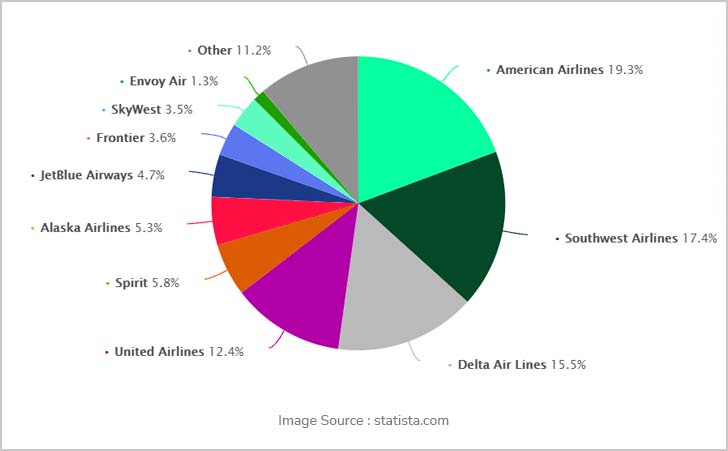
The above-exhibited statistics illustrate that American Airlines is the leading airline in the United States that has a domestic market share of 19.3 %. Furthermore, Southwest Airlines is the second leading airline company in the United States with a market share of 17.4 people in 2020. Besides this, Delta Airlines also has achieved a market share of 15.5 % in the airline industry in 2020. Hence, it is seen that the leading airline companies operating in the US include Southwest Airlines, Delta Airlines, and United Airlines.
Besides this, Qantas also offers its services in North America through six gateway cities which include Dallas Worth, Los Angeles, San Francisco, New York, Chicago and Honolulu. Qanytas has adopted a mix of centralized and decentralized organizational structure to manage its operations at international scale. However, Southwest Airlines has adopted a U-form organization structure where the business activities are managed on the basis of different functions but centralized decision making is managed in the organization.
For more detail, study our blog on organization structure and subsidiaries of Qantas.
Southwest Airlines Competitive strategy
The major competitive strategy of Southwest Airlines is the low-cost model that helps to attract and retain a large number of passengers. Furthermore, Southwest Airlines uses Boeing aircraft that helps to ensure fuel efficiency as well as cost-efficiency. The company also has placed an order for hundreds of Boeing's smallest 737 max models to ensure cost-effectiveness by maintaining operational efficiencies of all Boeing 737 fleet that helps to support low-cost and point-to-point support networks (Josephs, 2021). This also helps Southwest Airlines to maintain a differentiation advantage by offering cost-effective services to the passengers. Moreover, the point-to-point model also offers more versatile travel options and flexibility to the passengers as compared to the hub and spoke model that involves fewer routes and rigidity.

Southwest Airlines positioning analysis
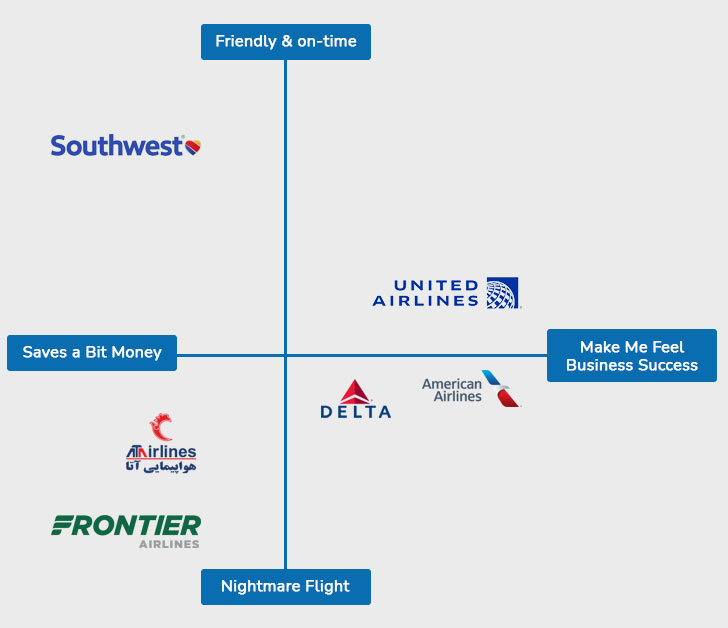
The figure depicts Southwest Airlines not only offers friendly and on-time facilities to the passengers but also helps them to save a bit of money through a low-cost operating model.
Southwest Airlines Internal analysis
Southwest Airlines VRIO analysis
VRIO analysis is an important internal analysis tool that helps to evaluate the core resources and capabilities of the organization. To analyze the core resources and capabilities of Southwest Airlines, VRIO analysis is performed as follows-
| Resources and capabilities | Valuable | Rare | Inimitable | Organized | Competitive advantage |
|---|---|---|---|---|---|
| Financial resources | Yes | Yes | No | No | Temporary competitive advantage |
| Service portfolio | Yes | Yes | No | No | Temporary competitive advantage |
| Point to point service model | Yes | Yes | Yes | Yes | Permanent competitive advantage |
| Cost structure | Yes | Yes | Yes | Yes | Permanent competitive advantage |
| Ancillary services | Yes | Yes | Yes | Yes | Permanent competitive advantage |
| Distribution channel | Yes | Yes | Yes | No | Unused competitive advantage |
| Technological advancement | Yes | No | No | No | Competitive parity |
| Human resources | Yes | Yes | Yes | Yes | Permanent competitive advantage |
| Fuel efficiency | Yes | Yes | Yes | Yes | Permanent competitive advantage |
Southwest Airlines Non-Core Competencies and Competitive Disadvantage
Southwest Airlines has implemented various technological initiatives such as a rapid reward program, remote working, and enhancement of customer self-service capabilities in the current times to support ongoing operations, reduce operational expenditure and capital requirements. But, we need to consider that the technological initiatives taken by Southwest Airlines are not in line with the technological initiatives of competitive firms. Along with this, various technical issues have been faced at Southwest Airlines which has resulted in the delays of a number of flights as well as the cancellation of around 500 flights. The network connectivity issue is one of the major challenges that has been faced by Southwest Airlines which also has affected the reservation system of the company (Moon, 2021). The financial resource of the company is one of the key areas of concern in the current time as the outbreak of COVID-19 negatively impacted the overall financial position of Southwest Airlines with the temporary suspension of the tourism and travel industry. The company suffered a net loss of $ 3.1 billion as a result of it, where the operating revenues of the company fell by 92 % in April 2020 as compared to 2019. The overall financial position of the company and the current time is shown as follows-

Besides this, Southwest Airlines adopted a direct-to-the-customer distribution approach through an internet website which helps to generate huge revenue for the company by offering a low-cost solution to the customers. The Direct to customer distribution approach offers a cost advantage to the company and helps to eliminate costs associated with the involvement of the third-party distribution channels. However, it is still the area of non-core competency for the organization as various other Airlines service companies offer direct booking facilities to their customers.
Southwest Airlines Core Competencies, Resources & Capabilities
The core competencies of Southwest Airlines include low-cost solutions, fuel efficiency, human resource capabilities, ancillary services, and a point-to-point model. Southwest Airlines continues to engage in initiatives that help to reduce fuel consumption and improve the fuel efficiency of the organization. The company also has been able to reduce the average cost of fuel since 2009 through appropriate modernization and implementation of other fuel initiatives which is shown as follows-
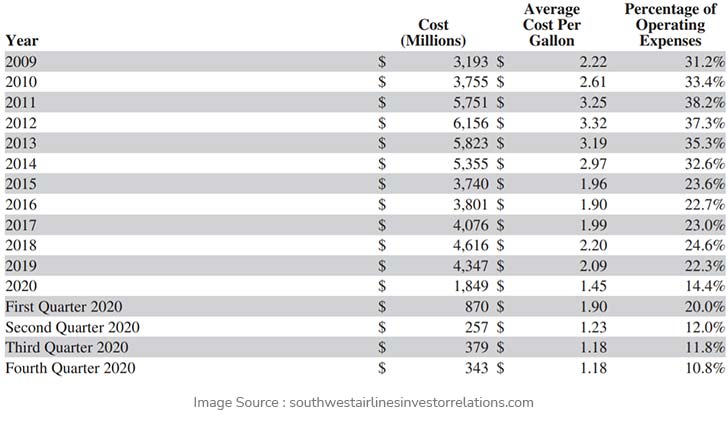
The company also ensures the use of Boeing 737 -300 aircraft in its fleet which helps to promote fuel efficiency and reduction of GHG emissions in the environment. The main core competency of Southwest Airlines is focused on Cost discipline and charging low fares from the customers. The point-to-point route structure of Southwest Airlines also helps to promote efficiency by providing convenient and frequent timed flights to the customers at low fares. Southwest Airlines’ approach to human capital is one of the critical strategies that help to achieve a strong competitive position in the industry as Southwest Airlines has implemented various programs and policies for promoting employee training, development, and growth. Moreover, Southwest Airlines also regularly conducts employee surveys to assess the job satisfaction of the employees and to improve the organization’s ability to attract, develop as well as retain talented employees at the workplace.
Southwest Airlines SWOT analysis
SWOT analysis is an important strategic analysis and planning tool that helps to assess not only the internal strengths and weaknesses of the organization but also helps to evaluate the external market threats as well as opportunities for the organization. The SWOT analysis of Southwest Airlines is illustrated below.
| Strengths | Weaknesses |
|---|---|
|
|
| Opportunities | Threats |
|
|
From the above analysis, it is seen that despite strong business strategies, Southwest Airlines is facing diverse challenges due to the outbreak of COVID-19, volatile fuel prices, competitive pressures, and new regulations. However, it is suggested that the company should implement technological advancement to improve its business growth and customer service experience. Moreover, the company currently offers its services majorly in the US but it is essential from a growth point of view that the company expands its service network and operations in international markets to improve its competitive position in the market and compete with international leaders in commercial aviation that include the likes of Qantas, British Airways, Emirates and so on.
Southwest Airlines Business strategy analysis
The main business strategy adopted by Southwest Airlines is low-cost services and point to point business model. In the point-to-point business model, Southwest Airlines ensures that each flight is a single journey which helps to ensure higher flexibility and offers more travel options to the passengers. Further, Southwest Airlines keeps the customer at the center of its operation and allows two check-in bags free of cost. Further, the company offers various ancillary services to customers to further ensure higher passenger satisfaction and the main ancillary services include free Wi-Fi Services, free in-flight entertainment through live TV, movies, and the use of iMessages. The company operates through Boeing 737 aircraft with the aim to improve fuel efficiency and save a lot of money by training cabin crew on only one type of aircraft. Furthermore, this also helps the company to reduce its cost by maintaining an inventory of only one type of aircraft. Furthermore, the right recruitment policies of Southwest Airlines are also aimed at improving the customer service experience.
Southwest Airlines Business Model
The business model of Southwest Airlines is extremely focused on efficient operations, low-cost pricing as well as strong customer service experience. Southwest Airlines put three themes together in its operation which include low cost, the best schedule as well as best service for the customers. Along with this, Southwest Airlines has also focused on adopting direct-to-customer distribution channels to further ensure low costs of operations.
Southwest Airlines business canvas model
| Key partners | Key activities | Value propositions | Customer relationships | Customer segments |
|---|---|---|---|---|
|
|
|
|
|
| Key resources | Key Channels | |||
|
| |||
| Cost structure | Revenue streams | |||
|
| |||
Southwest Airlines marketing analysis
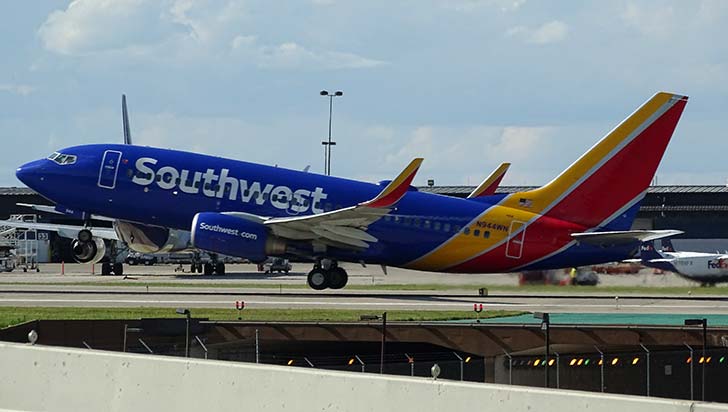
Southwest Airlines Marketing mix
The marketing mix helps to assess the marketing actions and tactics of the organization. The marketing mix of Southwest Airlines is evaluated as follows-
Southwest Airlines product strategy
Southwest Airlines uses the Boeing 737 in its fleet with the aim to ensure fuel efficiency in its operation. Further, the fare product mainly includes Wanna Get Away, Business Select, and Anytime where the company aims to provide a variety of options to the customer when choosing a fare. The company also offers various ancillary services to the customers such as free Wi-Fi, free inflight non-alcoholic beverages, Southwest’s EarlyBird Check-In, transportation of pets, and upgraded boarding. Along with this, the company also offers snacks to the customer without any extra cost, and the aircraft is also equipped with free eBooks, live television, Beats Audio, etc.
Southwest Airlines pricing strategy
Southwest Airlines has adopted a low-cost pricing strategy for its customer through point to point model and operation of low-cost carriers. Further, the company also offers only snacks and beverages to the customer rather than full meals to cut down extra costs from its service portfolio. Despite this, variable or dynamic pricing strategies are also adopted by Southwest Airlines where discounts are offered to customers who booked their tickets in advance for about three weeks (Ren, 2020).
Southwest Airlines distribution strategy
Southwest Airlines has adopted Direct to customer distribution approach with the aim to cut down the cost associated with services of third parties in Distribution Networks. However, the company is also currently expanding its distribution network by involving third-party providers to further expand its market and customer base (Sabre, 2021). The company also differentiates itself by focusing on short-distance routes through point-to-point flights which also helps to reduce the cost of operation and improve customer satisfaction. Further, Southwest Airlines operates in mid-size cities to keep its operation cost very low and initially, the company had its operations in Texas but later the operations of Southwest Airlines were extended to other neighboring cities in North America. Over the period of time, Southwest Airlines has expanded its presence in the international market through the inclusion of flights in eight countries which include Central America, and Caribbean Mexico, and Puerto Rico.
Southwest Airlines promotion strategy
Southwest Airlines has adopted an Integrated Marketing strategy with the aim to establish a strong brand image. The company uses catchy slogans to Grab the attention of a large number of customers in the market. Also, Southwest Airlines regularly launches various campaigns laced with humor and catchy slogans that help to attract a number of customers. The company also introduced Rapid reward programs for every flight to further ensure higher customer satisfaction. Southwest Airlines is the main sponsor of league baseball teams such as the Baltimore Orioles, San Diego, and Texas Rangers. Also, the company is also the official sponsor of NBA teams like Indiana Pacers, Houston Rockets, and Orlando magic. Not just this, Southwest Airlines also implemented a number of campaigns during the COVID-19 pandemic with the aim to ensure the strong commitment of its customers and employees. The company launched flights at $ 49 only to attract a number of customers during COVID-19. Southwest Airlines raised spending on its Facebook advertisements during COVID-19 to further attract a large number of passengers in the air and off to domestic as well as tropical destinations. The monthly spending of Southwest Airlines in different social media and other advertising channels is shown as follows-
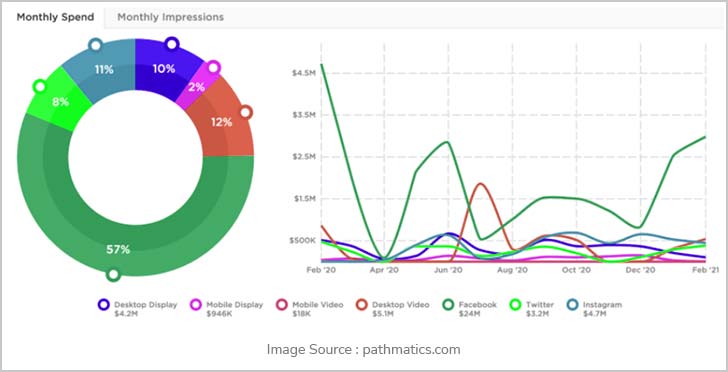
Southwest Airlines social media analysis
Southwest Airlines also uses various social media sites to further engage with customers on a real-time basis (Hoopfer, 2021). The main social media platforms used by Southwest Airlines include Facebook, Twitter, YouTube, and Instagram. Nearly three fourths of Americans use Facebook and Southwest Airlines has around 6,155,628 fans on its Facebook page which helps to raise brand awareness. The company regularly posts various texts and images on its Facebook page regarding its Boeing aircraft and other services to attract a large number of customers (Schweiger, 2021). The company also personalizes its content on the social media sites according to the customers by posting customer stories riding Southwest Airlines. Not just this, Southwest Airlines also launches various social media campaigns at regular intervals to further promote its brand visibility. The recent campaign of Southwest Airlines is #WannaGetAway contest on Instagram, YouTube, and Twitter where the people are encouraged to post a video or tell their story of an embarrassing moment in their life and the best story is given a gateway to an island provided by Southwest (Mutzabaugh, 2016).
Southwest Airlines STP analysis
Southwest Airlines Market segmentation
The market segmentation of Southwest Airlines is performed as follows-
| Segmentation | Segmentation criteria | Customers |
|---|---|---|
| Geographic | Region | United States and some international countries |
| Density | Urban | |
| Demographic | Age | Above 18 years of age |
| Gender | Both male and female | |
| Occupation | Students, employed individuals, professionals, etc. | |
| Income level | Middle-income group people | |
| Psychographic | Social class | Middle to upper-class group people |
| Lifestyle | Aspirer, reformed, succeeder, and explorer | |
| Behavior | User status | Non-users, first-time users, regular and potential users. |
| Personality | Determined and ambitious |
Southwest Airlines Target Market
Southwest Airlines offers low-cost carrier services to the customers and thus, the main target market of Southwest Airlines includes middle to income group people. Further, the company targets customers above the age of 18 years and offers different types of fares according to the income profile of the customers. The niche Southwest Airlines market of Southwest Airlines includes cost-conscious and no-frills Traveller. The company also targets frequent flyers through low-cost strategies.
Southwest Airlines positioning
Southwest Airlines is positioned as a low-cost carrier company focusing on creating a fun and enjoyable customer service experience through High-Quality Services and free in-flight TV and other facilities. The current motto of Southwest Airlines is “Low fares. Nothing to hide” which also helps to attract a large number of customers through a culture of transparency among employees as well as customers.
Southwest Airlines Recommendations
The detailed analysis of the current position of Southwest Airlines has helped to determine that it is one of the leading Airlines in the United States that offers low-cost carrier services to the customers with a focus on high-quality service experience. However, it is found the higher focus of the company on low-cost strategies and inability to fly to the long routes due to a point-to-point model may limit the overall ability of the company to expand in the long run. Hence, the following are some of the recommended measures that can be taken by Southwest Airlines to improve its competitive position in the long run.
- Southwest Airlines should implement advanced Technologies to improve customer service experience and to prevent various technical issues relating to network connectivity. The information system of the company should also be updated to serve the International Travellers and to handle Complex ticketing mechanisms.
- The company should also focus on indirect distribution channels to further improve its brand image and to increase its revenue by ensuring ticket booking by third parties such as travel agencies.
- Southwest Airlines should also implement a product development strategy under the Ansoff Matrix to further improve its competitive position in the industry. The company should move on its plan to add 33 new aircraft to expand its service base. The company should also add additional seats to further retain its seat capacity and reduce operational costs as well as increase fuel efficiency.
- Southwest Airlines should also implement various discounts and promotional strategies to attract a number of business travelers to raise its revenue without lowering its operational cost.
- Southwest Airlines should also expand its ancillary products and services by offering taxi services, hotels, and car rentals to further expand its revenue base and improve its competitive position in the industry.
- Market development is one of the other strategies that can be adopted by Southwest Airlines to fly longer distances and to destinations outside the United States. The company should acquire new Aircraft for this purpose to explore new long distances.
Conclusion
In this article, a detailed strategic analysis of Southwest Airlines is performed where it is found that Southwest Airlines is one of the leading airline companies in the United States that has established a strong brand image in the industry due to its low-cost pricing strategies. However, it is found that the current financial performance of Southwest Airlines is not much good due to the outbreak of COVID-19 and increasing competitive pressures in the industry. Hence, it is recommended that the company should focus on expanding its service base to deal with competitive pressure and to expand its revenue streams.
References
- Airways. (2020). How Airlines Have Changed to Appeal More to Millennial Audiences | Airways Magazine. Airways Magazine. Retrieved 29 September 2021, from https://airwaysmag.com/industry/how-airlines-appeal-to-millennials/.
- Aljazeera. (2021). Unruly skies: Union chief highlights airline passenger misconduct. Aljazeera.com. Retrieved 29 September 2021, from https://www.aljazeera.com/economy/2021/5/25/unruly-skies-union-chief-highlights-airline-passenger-misconduct.
- Biden. (2021). FACT SHEET: Biden Administration Advances the Future of Sustainable Fuels in American Aviation | The White House. The White House. Retrieved 29 September 2021, from https://www.whitehouse.gov/briefing-room/statements-releases/2021/09/09/fact-sheet-biden-administration-advances-the-future-of-sustainable-fuels-in-american-aviation/.
- Business. (2020). Southwest Airlines: Vision | Mission | Values | Philosophy (2020). Business Strategy Hub. Retrieved 28 September 2021, from https://bstrategyhub.com/Southwest-airlines-vision-mission-values-philosophy-2020/.
- Chee, Y. (2019). Airline industry group slashes its profit forecast as trade war hurts the cargo business. cnbc. Retrieved 29 September 2021, from https://www.cnbc.com/2019/06/02/airline-industry-cuts-profit-outlook-cargo-business-hurt-by-trade-war.html.
- Future. (2021). 12 technology trends for airlines and airports to focus on in 2020. Future Travel Experience. Retrieved 29 September 2021, from https://www.futuretravelexperience.com/2020/01/12-technology-trends-for-airlines-and-airports-to-focus-on-in-2020/.
- Hoopfer, E. (2021). Social media LUV: How Southwest Airlines connects with customers online. Bizjournals.com. Retrieved 29 September 2021, from https://www.bizjournals.com/dallas/news/2019/03/03/Southwest-airlines-social-media.html.
- IBISWorld. (2021). IBISWorld - Industry Market Research, Reports, and Statistics. Ibisworld.com. Retrieved 28 September 2021, from https://www.ibisworld.com/industry-statistics/market-size/domestic-airlines-united-states/.
- Josephs, L. (2021). Airlines’ latest challenge: Rising jet fuel prices. cnbc. Retrieved 29 September 2021, from https://www.cnbc.com/2021/02/19/winter-storm-oil-jet-fuel-prices-hit-airlines.html.
- Josephs, L. (2021). Southwest Airlines agrees to buy 100 of Boeing’s smallest 737 Max model. cnbc. Retrieved 29 September 2021, from https://www.cnbc.com/2021/03/29/Southwest-airlines-adds-100-orders-for-boeing-737-max-jet.html.
- Moon, M. (2021). Engadget is now a part of Verizon Media. Engadget.com. Retrieved 29 September 2021, from https://www.engadget.com/Southwest-airlines-technical-issues-500-canceled-flights-033044681.html.
- Mordorintelligence. (2021). Aviation Market | 2021 - 2026 | Industry Share, Size, Growth - Mordor Intelligence. Mordorintelligence.com. Retrieved 29 September 2021, from https://www.mordorintelligence.com/industry-reports/aviation-market.
- Mutzabaugh, B. (2016). Remember Southwest's 'Wanna Get Away' ads? They're back!. Usatoday.com. Retrieved 29 September 2021, from https://www.usatoday.com/story/travel/flights/todayinthesky/2016/09/06/remember-Southwests-wanna-get-away-ads-theyre-back/89899304/.
- Pratap, A. (2021). Who are the leading competitors of Southwest Airlines: . notesmatic. Retrieved 29 September 2021, from https://notesmatic.com/who-are-the-leading-competitors-of-Southwest-airlines-%EF%BB%BF/.
- Ren, J. (2020). Fare impacts of Southwest Airlines: A comparison of nonstop and connecting flights. Journal Of Air Transport Management, 84, 101771. https://doi.org/10.1016/j.jairtraman.2020.101771
- Sabre. (2021). Flipping the industry trend: Southwest Airlines’ shift to indirect distribution. Sabre. Retrieved 29 September 2021, from https://www.sabre.com/insights/flipping-the-industry-trend-Southwest-airlines-shift-to-indirect-distribution/.
- Schweiger, B. (2021). Social media Savvy: Southwest Airlines. Newmedia.cas.msu.edu. Retrieved 29 September 2021, from https://newmediadl.cas.msu.edu/example-work/posts/174776.
- Shepardson, D. (2021). The U.S. FAA wants airlines to do more to address unruly passengers. Reuters. Retrieved 29 September 2021, from https://www.reuters.com/business/aerospace-defense/us-faa-wants-airlines-do-more-address-unruly-passengers-2021-09-21/.
- Simple Flying. (2021). The History Of Southwest Airlines. Simple Flying. Retrieved 28 September 2021, from https://simpleflying.com/Southwest-airlines-history/.
- Statista. (2021). Airline industry revenue worldwide 2019 | Statista. Statista. Retrieved 28 September 2021, from https://www.statista.com/statistics/278372/revenue-of-commercial-airlines-worldwide/.
